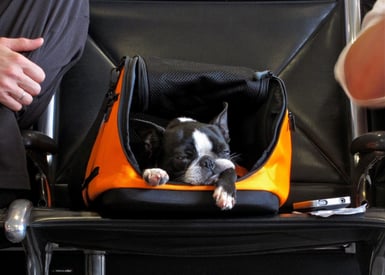Procedure to import pets to Mexico
When you live abroad and decide to return to your country, you take all your belongings with you and, of course, what you value most: your pets.
As mentioned in our article on the Requirements for importing household goods to Mexico, it can be difficult to import your entire move to a country due to the requested regulations, and it's not the exception when you want to enter your pets. For this reason, we share with you the procedure that you must carry out to import your pet to Mexico without any problems.

According to Mexican laws, as long as the Zoosanitary Export Certificate (issued by SAGARPA) is presented at customs, you can import two pets with you without paying taxes, as well as the accessories they need for grooming and transfer. These pets can be the following:
![]()
* Regarding wildlife animals, the Verification Registry issued by Profepa must be presented, which shows compliance with the non-tariff regulation or restriction to which they are subject.

The following are the steps and requirements to be met before the Animal and Plant Health Inspection Offices (OISA) located at international airports, border crossings, and international seaports.
1. Delivery and review of documents at the OISA
Present a copy and original of the Zoosanitary Export Certificate (Health Certificate) issued by the corresponding Federal Authority or a Veterinarian from the country where the pet arrives.
- In case the certificate is issued by a Veterinarian, it must be presented printed or photocopied on letterhead along with the professional certificate (or equivalent document in the country) and must indicate the following:
- A maximum validity of 10 days after being issued.
- Full name and address of the exporter and importer, with the identification data of the pet and its final destination.
- Rabies vaccine, its date of application and validity. Animals under 3 months of age are exempt from this requirement.
- Check that the animals received preventive treatment against internal and external parasites within 6 months prior to their transfer and that they're free of external parasites.
- It is stated that, after inspection, the pet was found to be clinically healthy prior to export.
* If in the documentary verification, the health certificate does not indicate any of the above requirements, you may present the vaccination card (original and copy) containing the missing requirements, or if necessary, contact a Zootechnical Veterinarian who applies the missing treatments (these costs would be the responsibility of the interested party).
2. Physical inspection of pets at OISA
It’s verified that the pet matches its physical description detailed in the Health Certificate (regarding its race, color, and sex), also checking its state of health and that it is free of external parasites.
* If it is detected that the pet is not free of external parasites, a private Zootechnical Veterinarian will apply the corresponding treatment, at the expense of the importer.
3. Issuance of the Zoosanitary Export Certificate in the OISA
As soon as the established requirements are met, an official OISA staff will deliver the Zoosanitary Export Certificate.
- When transporting one or two pets, no payment is required.
- If you transport three or more, you must make the payment of $1,620.00 (Mexican pesos) electronically or at a bank window, corresponding to the Zoosanitary Export Certificate.
- For three or more, the Customs authority will order their transfer to the cargo area, where they must comply with the national regulation of commercial importation and carry out their procedure in the OISA.
Arrival in the country without Zoosanitary documents
Upon entering Mexico without the required documentation, the animals will remain in the Sanitary Inspection Office until they can be examined and verified by a Veterinarian, applying the necessary parasiticide preventive treatment and the necessary rabies vaccine to continue with the import process.
This isn't recommended as there can be costs that the pet owner will have to bear and setbacks or inconveniences.

Notes and clarifications
- In addition to meeting the above requirements, the importer must also present to the authorities the necessary documents and procedures for entering the country. Which you can consult in our document: Customs Regulation Mexico
- The bed or similar items that usually accompany the animal are not allowed; you can only enter the food ratio corresponding to the day of arrival.
- If you need further assistance upon arrival in Mexico, an OISA officer will inform you of the procedure.
* It's important to point out that the Mexican Consular Network is not authorized to intervene in the previous process, but they will be able to provide the information needed by those who are interested.
* It is also important to mention that in Mexico only cats and dogs are considered pets. In the importation of different animals (reptile, songbird and ornamental bird, ferret and turtle), certain requirements established in the Zoosanitary Requirements Sheet must be met, which are issued in writing at the offices of the State Delegations of SAGARPA or the Mexican Animal Health Directorate.
* Consult all the information (in Spanish) about the Zoosanitary Requirements Sheet - Click here


